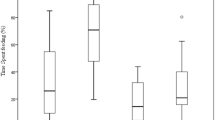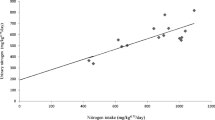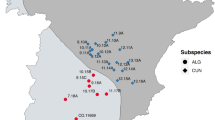Abstract
Sagebrush (Artemisia tridentata) comprises up to 99% of the winter and 50% of the summer diets of pygmy rabbits (Brachylagus idahoensis). Few animals specialize on such plants as sagebrush, which contain high levels of plant chemicals that can be toxic. We investigated the nutritional requirements of pygmy rabbits and their ability and propensity to consume sagebrush alone and as part of a mixed diet. We compared diet choices of pygmy rabbits with that of a generalist forager, the eastern cottontail (Sylvilagus floridanus). Pygmy rabbits had a moderately low nitrogen requirement (306.5 mg N/kg0.75/d), but a relatively high energy requirement, needing 750.8 kJ digestible energy/kg0.75/d to maintain their body mass while residing in small cages. They digested fiber in pelleted diets similarly to other small hindgut fermenters, but both cottontails and pygmy rabbits digested the fiber in sagebrush better than expected based on its indigestible acid detergent lignin content. Pygmy rabbits consumed more sagebrush than cottontails, regardless of the amount and nutritional quality of supplemental pellets provided. When consuming sagebrush alone, they ate barely enough to meet their energy requirements, whereas cottontails ate only enough sagebrush to meet 67% of theirs. Both rabbit species ate more sagebrush as the quality and quantity of supplemental pellets declined, and more greenhouse-grown sagebrush than sagebrush grown outside. Urine was more acidic when consuming sagebrush than when consuming pellets, indicating detoxification by the liver. Pygmy rabbits do not require sagebrush to survive, but seem to tolerate terpenes and other plant chemicals in sagebrush better than cottontails do.







Similar content being viewed by others
References
Boyle, R. R. and McLean, S. 2004. Constraint of feeding by chronic ingestion of 1,8-cineole in the brushtail possum (Trichosurus vulpecula). J. Chem. Ecol. 30:757–775.
Boyle, R. T., McLean, S., Davies, N., Foley, W., and Moore, B. 1999. Folivorous specialization: adaptations in the detoxification of the dietary terpene, p-cymene, in Australian marsupial folivores. Am. Zool. 39:120A.
Bray, R. O., Wambolt, C. L., and Kelsey, R. G. 1991. Influence of sagebrush terpenoids on mule deer preference. J. Chem. Ecol. 17:2053–2062.
Brown, D. R., Asplund, O., and McMahon, V. A. 1975. Phenolic constituents of Artemisia tridentata sp. vaseyana. Phytochemistry 14:1083–1084.
Burritt, E. A., Banner, R. E., and Provenza, F. D. 2000. Sagebrush ingestion by lambs: effects of experience and macronutrients. J. Range Manag. 53:91–96.
Cluff, L. K., Welch, B. L., Pederson, J. C., and Brotherson, J. D. 1982. Concentration of monoterpenoids in the rumen ingesta of wild mule deer. J. Range Manag. 35:192–194.
Cork, S. J. and Foley, W. J. 1991. Digestive and metabolic strategies of arboreal mammalian folivores in relation to chemical defenses in temperate and tropical forests, pp. 133–155, in R. T. Palo and C. T. Robbins (eds.). Plant Defenses Against Mammalian Herbivory. CRC Press, Boca Raton, FL.
Dearing, M. D., Mangione, A. M., and Karasov, W. H. 2000. Diet breadth of mammalian herbivores: nutrient versus detoxification constraints. Oecologia 123:397–405.
Dearing, M. D., Foley, W. J., and McLean, S. 2005. The influence of plant secondary metabolites in the nutritional ecology of herbivorous terrestrial vertebrates. Annu. Rev. Ecol. Evol. Syst. 36:169–189.
Demment, M. W. and Van Soest, P. J. 1985. A nutritional explanation for body-size patterns of ruminant and nonruminant herbivores. Am. Nat. 125:641–672.
Dial, K. P. 1988. Three sympatric species of Neotoma: dietary specialization and coexistence. Oecologia 76:531–537.
Federal Register, November 10, 2003. Endangered and threatened wildlife and plants; Final rule to list the Columbia Basin Distinct Population Segment of Pygmy Rabbits (Brachylagus idahoensis) as endangered. 68:10388–10409.
Federal Register, May 20, 2005. Endangered and threatened wildlife and plants: 90-day finding on petition to list the pygmy rabbit as threatened and endangered. 70:29253–29265.
Foley, W. J. 1992. Nitrogen and energy retention and acid–base status in the common ringtail possum (Pseudocheirus peregrinus): Evidence of the effects of absorbed allelochemicals. Phys. Zool. 65:403–421.
Foley, W. J., McLean, S., and Cork, S. J. 1995. Consequences of biotransformation of plant secondary metabolites on acid–base metabolism in mammals—A final common pathway? J. Chem. Ecol. 21:721–743.
Freeland, W. J. 1991. Plant secondary metabolites: biochemical coevolution with herbivores, pp. 61–81, in R. T. Palo and C. T. Robbins (eds.). Plant Defenses Against Mammalian Herbivory. CRC Press, Boca Raton, FL.
Freeland, W. J. and Janzen, D. H. 1974. Strategies in herbivory by mammals: the role of secondary compounds. Am. Nat. 108:269–289.
Gershenzon, J. and Croteau, R. 1991. Herbivores: their Interactions with Secondary Plant Metabolites, Vol. 1. Academic Press, Inc, San Diego, CA.
Goering, H. K. and Van Soest, P. J. 1970. Forage Fiber Analyses, Reagents, Procedures, And Some Applications. Agriculture Handbook 379. U.S. Government Printing Office, Washington, DC.
Green, J. S. and Flinders, J. T. 1980a. Brachylagus idahoensis. Mamm. Species 125:1–4.
Green, J. S. and Flinders, J. T. 1980b. Habitat and dietary relationships of the pygmy rabbits. J. Range Manag. 33:136–142.
Harborne, J. B. 1991. The chemical basis of plant defense, pp. 45–60, in R. T. Palo and C. T. Robbins (eds.). Plant Defenses Against Mammalian Herbivory. CRC Press, Boca Raton, FL.
Holter, J. B., Tyler, G., and Walski, T. W. 1974. Nutrition of the snowshoe hare (Lepus americanus). Can. J. Zool. 52:1553–1555.
Johnson, A. E., James, L. F., and Spillett, J. 1976. The abortifacient and toxic effects of big sagebrush (Artemisia tridentata) and juniper (Juniperus osteosperma) on domestic sheep. J. Range Manag. 29:278–280.
Katzner, T. E. and Parker, K. L. 1997a. Vegetative characteristics and size of home ranges used by pygmy rabbits (Brachylagus idahoensis) during winter. J. Mamm. 78:1063–1072.
Katzner, T. E., Parker, K. L., and Harlow, H. H. 1997b. Metabolism and thermal response in winter-acclimatized pygmy rabbits (Brachylagus idahoensis). J. Mamm. 78:1053–1062.
Kuijper, D. P. J., Van Wieren, S. E., and Bakker, J. P. 2004. Digestive strategies in two sympatrically occurring lagomorphs. J. Zool. Lond. 264:171–178.
Lawler, I. R., Foley, W. J., Eschler, B. M., Pass, D. M., and Handasyde, K. 1998. Interspecific variation in Eucalyptus secondary metabolites determines food intake by folivorous marsupials. Oecologia 116:160–169.
Lawler, I. R., Stapley, J., Foley, W. J., and Eschler, B. 1999. Ecological example of conditioned food aversion in plant–herbivore interactions: effect of terpenes of Eucalyptus leaves on feeding by common ringtail and brushtail possums. J. Chem. Ecol. 25:401–415.
Marsh, K. J., Wallis, I. R., and Foley, W. J. 2003. The effect of inactivating tannins on the intake of Eucalyptus foliage by a specialist Eucalyptus folivore (Pseudocheirus peregrinus) and a generalist herbivore (Trichosurus vulpecula). Aust. J. Zool. 51:31–42.
Martin, J. S. and Martin, M. M. 1982. Tannin assays in ecological studies: lack of correlation between phenolics, proanthocyanidins and protein-precipitating constituents in mature foliage of size oak species. Oecologia 54:205–211.
McAllister, K. R. 1995. Washington state recovery plan for the pygmy rabbit. Wildlife Management Program, Washington Department of Fish and Wildlife, Olympia, Washington.
McArthur, C., Hagerman, A. E., and Robbins, C. T. 1991. Physiological strategies of mammalian herbivores against plant defenses, pp. 103–114, in R. T. Palo and C. T. Robbins (eds.). Plant Defenses Against Mammalian Herbivory. CRC Press, Boca Raton, FL.
McLean, S., Foley, W. J., Davies, N. W., Brandon, S., Duo, L., and Blackman, A. J. 1993. Metabolic fate of dietary terpenes from Eucalyptus radiate in common ringtail possum (Pseudocheirus peregrinus). J. Chem. Ecol. 19:1625–1643.
McNab, B. K. 1988. Complications inherent in scaling the basal rate of metabolism in mammals. Q. Rev. Biol. 63:25–54.
Meyer, M. W. and Karasov, W. H. 1991. Chemical aspects of herbivory in arid and semiarid habitats, pp 167–186, in R. T. Palo and C. T. Robbins (eds.). Plant Defenses Against Mammalian Herbivory. CRC Press, Boca Raton, FL.
Moore, B. D. and Foley, W. J. 2000. A review of feeding and diet selection in koalas (Phascolarctos cinereus). Aust. J. Zool. 48:317–333.
Nagy, J. G., Steinhoff, H. W., and Ward, G. M. 1964. Effects of essential oils of sagebrush on deer rumen microbial function. J. Wildl. Manage. 28:785–791.
Nagy, K. A., Shoemaker, V. H., and Costa, W. R. 1976. Water, electrolyte, and nitrogen budgets of jackrabbits (Lepus californicus) in the Mojave desert. Physiol. Zool. 49:351–363.
National Research Council (1977) Nutrient requirements of rabbits. Subcommittee on rabbit nutrition, Committee on Animal Nutrition, Board of Agriculture and Renewable Resources, National Research Council. National Academy of Science, Washington, DC.
Ngugi, K. R., Powell, J., Hinds, F. C., and Olson, R. A. 1992. Range animal diet composition in southcentral Wyoming. J. Range Manag. 45:542–545.
Nicholas, H. J. 1973. Terpenes, pp. 1254–1309, in L. P. Miller (ed.). Phytochemistry Vol. II. Organic Metabolites. Van Nostrand-Reinhold, New York.
Palo, R. T., Bergström, R., and Danell, K. 1992. Digestibility, distribution of phenols and fiber at different twig diameters of birch in winter. Implication for browsers. Oikos 65:450–454.
Rachlow, J. L., Sanchez, D. M., and Estes-Zump, W. A. 2005. Natal burrows and nests of free-ranging pygmy rabbits (Brachylagusidahoensis). West. N. Am. Nat. 65:136–139.
Radwan, M. A., Crouch, G. L., Harrington, C. A., and Ellis, W. D. 1982. Terpenes of ponderosa pine and feeding preferences by pocket gophers. J. Chem. Ecol. 8:241–253.
Robbins, C. T. 1993. Wildlife Feeding and Nutrition. Academic Press, San Diego, CA.
Rodgers, A. R., Williams, D., Sinclair, A. R. E., Sullivan, T. P., and Andersen, R. J. 1993. Does nursery production reduce antiherbivore defences of white spruce? Evidence from feeding experiments with snowshoe hares. Can. J. For. Res. 23:2358–2361.
Rose, G. 1973. Energy metabolism of adult cottontail rabbits, Sylvilagus floridanus, in simulated field conditions. Am. Midl. Nat. 89:473–478.
Schwartz, C. C., Nagy, J. G., and Regelin, W. L. 1980. Juniper oil yield, terpenoid concentration, and antimicrobial effects on deer. J. Wildl. Manage. 44:107–113.
Shafizadeh, F. and Melnikoff, A. B. 1970. Coumarins of Artemisia tridentata sp. Vaseyanoa. Phytochemistry 9:1311–1316.
Sinclair, A. R. E., Jogia, M. K., and Andersen, R. J. 1988. Camphor from juvenile white spruce as an antifeedant for showshoe hares. J. Chem. Ecol. 14:1505–1514.
Slade, L. M. and Robinson, D. W. 1970. Nitrogen metabolism in nonruminant herbivores. II. Comparative aspects of protein digestion. J. Anim. Sci. 30:761–763.
Sorensen, J. S. and Dearing, M. D. 2003. Elimination of plant toxins by herbivorous woodrats: revisiting an explanation for dietary specialization in mammalian herbivores. Oecologia 134:88–94.
Sorensen, J. S., Turnbull, C. A., and Dearing, M. D. 2004. A specialist herbivore (Neotoma stephensi) absorbs fewer plant toxins than does a generalist (Neotoma albigula). Physiol. Biochem. Zool. 77:139–148.
Sorensen, J. S., McLister, J. D., and Dearing, M. D. 2005. Plant secondary metabolites compromise the energy budgets of specialist and generalist mammalian herbivores. Ecology 86:125–139.
Thines, N. J. 2006. Effects of enhanced UV-B radiation on the nutritional chemistry of forages and influences on mammalian herbivores. PhD dissertation, Washington State University, Pullman, WA.
Thines, N. J., Shipley, L. A., and Sayler, R. D. 2004. Effects of cattle grazing on ecology and habitat of Columbia Basin pygmy rabbits (Brachylagus idahoensis). Biol. Conserv. 119:525–534.
Uresk, D. W. 1978. Diets of the black-tailed hare in steppe vegetation. J. Range Manag. 31:439–442.
Villalba, J. J. and Provenza, F. D. 2005. Foraging in chemically diverse environments: energy, protein, and alternative foods influence ingestion of plant secondary metabolites by lambs. J. Chem. Ecol. 31:123–138.
Welch, B. L. and McArthur, E. D. 1981. Variation of monoterpenoid content among subspecies and accessions of Artemisia tridentata grown in a uniform garden. J. Range Manag. 34:380–384.
Welch, B. L. and Pederson, J. C. 1981. In vitro digestibility among accessions of big sagebrush by wild mule deer and its relationship to monoterpenoid content. J. Range Manag. 34:497–500.
White, S. M., Flinders, J. T., and Welch, B. T. 1982a. Preference of pygmy rabbits (Brachylagus idahoensis) for various populations of big sagebrush (Artemisia tridentata). J. Range Manag. 35:724–726.
White, S. M., Welch, B. L., and Flinders, J. T. 1982b. Monoterpenoid content of pygmy rabbit stomach ingesta. J. Range Manag. 35:107–109.
Zhang, X. and States, J. S. 1991. Selective herbivory of ponderosa pine by Abert squirrels: a re-examination of the role of terpenes. Biochem. Syst. Ecol. 19:111–115.
Acknowledgments
We thank J. Jackson for help collecting data and caring for rabbits, G. K. Radamaker for raising sagebrush, and B. Davitt, R. Croteau, K. Ringer, and R. Goodwin for helping to analyze sagebrush for tannins and terpenes. J. Sorensen provided helpful comments on the manuscript. Support for this project came from Washington Department of Fish and Wildlife.
Author information
Authors and Affiliations
Corresponding author
Rights and permissions
About this article
Cite this article
Shipley, L.A., Davila, T.B., Thines, N.J. et al. Nutritional Requirements and Diet Choices of the Pygmy Rabbit (Brachylagus idahoensis): A Sagebrush Specialist. J Chem Ecol 32, 2455–2474 (2006). https://doi.org/10.1007/s10886-006-9156-2
Published:
Issue Date:
DOI: https://doi.org/10.1007/s10886-006-9156-2




